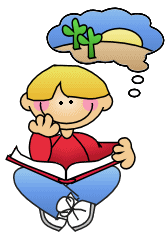Visual Imagery
"Good readers construct mental images as they read a text. By using prior knowledge and background experiences, readers connect the author's writing with a personal picture. Through guided visualization, students learn how to create mental pictures as they read." (Reading Rockets, 2015). Visual imagery can take place before, during, or after reading. It can be taught to small groups, whole group, or individually. Visualization is an important part of comprehension, because students need to be able to create the picture in their head of what is going on in the story. For the picture to flow and make sense, the students need to be comprehending their text.
When readers are having a hard time understanding what they are reading, this is a good strategy to teach them. It helps them to create images, scenarios, or movies in their minds that reflect to the text. Visualizing makes it easier for students to understand the text because they are looking beyond the words and creating images that help them understand the text.
When readers are having a hard time understanding what they are reading, this is a good strategy to teach them. It helps them to create images, scenarios, or movies in their minds that reflect to the text. Visualizing makes it easier for students to understand the text because they are looking beyond the words and creating images that help them understand the text.
One might imagine a sunset on the beach and hear the waves, smell the seaweed, feel a breeze, and clearly see the rich colors of the sunset as the Sun drops below the horizon." (McMahon, Wallace, 2015).
|
This special education teacher is modeling how to use this strategy effectively to her students. Instead of just telling the students what she is visualizing, she is drawing it out for them. She is taking all of the words from what she is reading and relating them to her pictures. The students will be able to adapt this into their own comprehension skill eventually, but they need to start with the basics.
JustificationOften times for struggling readers, words on a page are just that, but when we use a stregy that helps make the words on the page come alive it allows them to use their imagination and see more than just text. When students are creating images they can recall information easier, because they have a visual aid/representation to relate to the text. According to Harvey and Goudvis, visualizing strengthens students inferential thinking by having mental images rather than words and thoughts (Harvey and Goudvis, 2007). Also according to Wilson, her article states visualizing helps students feel more connected to the material and students are able to see the characters, be apart of the setting, and participate in the actions. It is like being apart of a film and brings the words on a page to life and helps them understand and connection to the text (Wilson, 2014). The authors of the text, Reading Problems: Assessment and Teaching Strategies, state that not all students learn through the same cognitive process. Some learners are visual learners and learn best through visualizing and having visual aids, so having students who struggle with reading will provide these students with a learner strategy that helps them effectively understand the material (Jennings, Caldwell, and Lerner, 2014).
|
Differentiation for ELLs
Tips• Use before, during, and after the reading.
• Allow time for students to discuss and share. • Use a book with a lot of details. • Read with expression to students |
Creating mental images while reading can improve comprehension." (Reading Rockets, 2015).
How to Teach Visual Imagery
- "Begin reading. Pause after a few sentences or paragraphs that contain good descriptive information.
- Share the image you've created in your mind, and talk about which words from the book helped you "draw" your picture. Your picture can relate to the setting, the characters, or the actions. By doing this, you are modeling the kind of picture making you want your child to do.
- Talk about how these pictures help you understand what's happening in the story.
- Continue reading. Pause again and share the new image you created. Then ask your child to share what he sees, hears, tastes, smells and feels. Ask what words helped him create the mental image and emotions. By doing this, you are providing your child with practice with this new skill.
- Are your images identical? Probably not! This is a great time to talk about why your images might be different. Perhaps your child went on a school field trip or had a school assembly that changed the way they created the picture in their mind. Perhaps experiences you've had as an adult influenced what you "drew." These differences are important to understand and respect.
- Read a longer portion of text and continue the sharing process.
- Once this is a familiar skill, encourage your child to use mental imagery when she is reading by herself. You can feel confident that these mental pictures will help your child understand the story in an important way." (Reading Rockets, 2015).
|
|
This is an example video of a visual imagery lesson. The teacher uses many different strategies to help her students comprehend the text. Watch as she models her skill for her students and helps her students to become successful. She prompts her students and gets them on the right track.
|
Content Area Visual Imagery

Reading: Students can use visualizing to connect to the text. After modeling and practicing the visualizing strategy, the students will be able to utilize this throughout all of their readings in their life. There are many books that can be used to model visual imagery such as: All the World, Tales of a 4th Grade Nothing, Bunnicula, and Aesop's Fables. These are a few examples of books that will help create vivid images for students and will help teachers be able to model this strategy clearly.
Mathematics: Students can use the visualizing strategy to think through math problems. They can begin with the end in mind, and visualize how they are going to solve the problems. While doing mathematics, first you will need to begin with the think-aloud strategy, and then visual imagery, because the students will need to know the process to arriving at an answer to the certain types of problems. "Look at this problem and picture in your mind how you are going to get an answer. Think about what steps you are going to have to use." This would be a sample statement for students when they are practicing visual imagery.
Science: When students are unable to take a trip to somewhere to explore, we can ask them to visualize going there. "Take yourself to a beach, somewhere with a salty ocean." This will help the students to visualize what it is like to go to the ocean. The students will use this strategy to connect to their science content. "Visualize how a rabbit's fur would feel," or "picture in your mind how it would smell if we were at a cow pasture." These types of statements will help students connect to their outside world.
Social Studies: "The language of social studies focuses on abstract concepts, but the field itself offers a wide variety of visuals that can help make instruction more comprehensible." (Wright, 2015). When students are able to use visualizing for social studies, they will be connecting to the reading in a whole new way. Cultures, places, and history are all important to the social studies content. "Close your eyes and picture yourself walking with Martin Luther King Jr. during his march. What would it feel like? Who would be with you?" This is an example of how we could use visualizing to help students connect to an important time in history. This is more effective than the students just reading it in the book. "
Mathematics: Students can use the visualizing strategy to think through math problems. They can begin with the end in mind, and visualize how they are going to solve the problems. While doing mathematics, first you will need to begin with the think-aloud strategy, and then visual imagery, because the students will need to know the process to arriving at an answer to the certain types of problems. "Look at this problem and picture in your mind how you are going to get an answer. Think about what steps you are going to have to use." This would be a sample statement for students when they are practicing visual imagery.
Science: When students are unable to take a trip to somewhere to explore, we can ask them to visualize going there. "Take yourself to a beach, somewhere with a salty ocean." This will help the students to visualize what it is like to go to the ocean. The students will use this strategy to connect to their science content. "Visualize how a rabbit's fur would feel," or "picture in your mind how it would smell if we were at a cow pasture." These types of statements will help students connect to their outside world.
Social Studies: "The language of social studies focuses on abstract concepts, but the field itself offers a wide variety of visuals that can help make instruction more comprehensible." (Wright, 2015). When students are able to use visualizing for social studies, they will be connecting to the reading in a whole new way. Cultures, places, and history are all important to the social studies content. "Close your eyes and picture yourself walking with Martin Luther King Jr. during his march. What would it feel like? Who would be with you?" This is an example of how we could use visualizing to help students connect to an important time in history. This is more effective than the students just reading it in the book. "
Did you know?Visual imagery can be treated as a stress management tool. It can be used to calm the students down as they begin to feel panicked.
|
Resources
Echevarría, J., Vogt, M., & Short, D. (2014). Making content comprehensible for elementary English learners: The SIOP model (2nd ed.). Boston, Massachusetts: Allyn & Bacon.
Jennings, J., Caldwell, J., & Lerner, J. (2014). Reading problems assessment and teaching strategies. Boston, MA: Pearson Education, Inc.
McMahon, M., & Wallace, O. (2015). What is visual imagery? Retrieved September 27, 2015. http://www.wisegeek.com/what-is-visual-imagery.htm
Model an example the first timeHarvey, S., & Goudvis, A (2000). Strategies that work: Teaching comprehension to enhance understanding. York, ME: Stenhouse.
Pounds, L. (2012, October 22). Increasing Reading Comprehension through Visualization. Retrieved September 27, 2015. https://www.youtube.com/watch?v=Uqdr4w7B5Xs
Visual Imagery. (2015). Retrieved September 27, 2015. http://www.readingrockets.org/strategies/visual_imagery
Visualizing Strategy. (2015). Retrieved September 18, 2015. http://www.readingrockets.org/article/key-comprehension-strategies-teach
Wright, W. E. (2010). Foundations for teaching English language learners: Research, theory, policy, and practice. Philadelphia: Caslon Pub.
Wilson, D. (2014). Brain Movies: When Readers Can Picture It, They Understand It. Edutopia. Retrieved on 9/21/15. From http://www.edutopia.org/blog/brain-movies-visualize-reading-comprehension-donna-wilson.
Jennings, J., Caldwell, J., & Lerner, J. (2014). Reading problems assessment and teaching strategies. Boston, MA: Pearson Education, Inc.
McMahon, M., & Wallace, O. (2015). What is visual imagery? Retrieved September 27, 2015. http://www.wisegeek.com/what-is-visual-imagery.htm
Model an example the first timeHarvey, S., & Goudvis, A (2000). Strategies that work: Teaching comprehension to enhance understanding. York, ME: Stenhouse.
Pounds, L. (2012, October 22). Increasing Reading Comprehension through Visualization. Retrieved September 27, 2015. https://www.youtube.com/watch?v=Uqdr4w7B5Xs
Visual Imagery. (2015). Retrieved September 27, 2015. http://www.readingrockets.org/strategies/visual_imagery
Visualizing Strategy. (2015). Retrieved September 18, 2015. http://www.readingrockets.org/article/key-comprehension-strategies-teach
Wright, W. E. (2010). Foundations for teaching English language learners: Research, theory, policy, and practice. Philadelphia: Caslon Pub.
Wilson, D. (2014). Brain Movies: When Readers Can Picture It, They Understand It. Edutopia. Retrieved on 9/21/15. From http://www.edutopia.org/blog/brain-movies-visualize-reading-comprehension-donna-wilson.

